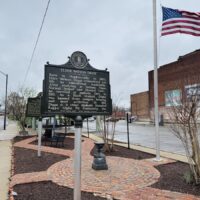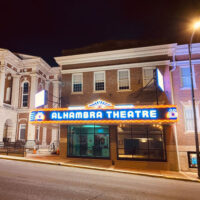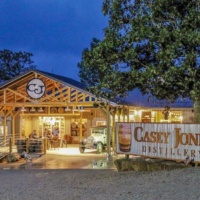This might be my favorite vista from the Dalton house — an arcade of porches lining East Seventh Street. These four porches belong to the most intact, contiguous section of the East Seventh Street Historic District, addresses 713 through 805. The view drives home the fact that these historic houses form a community. Each house adds something to the house next to it.
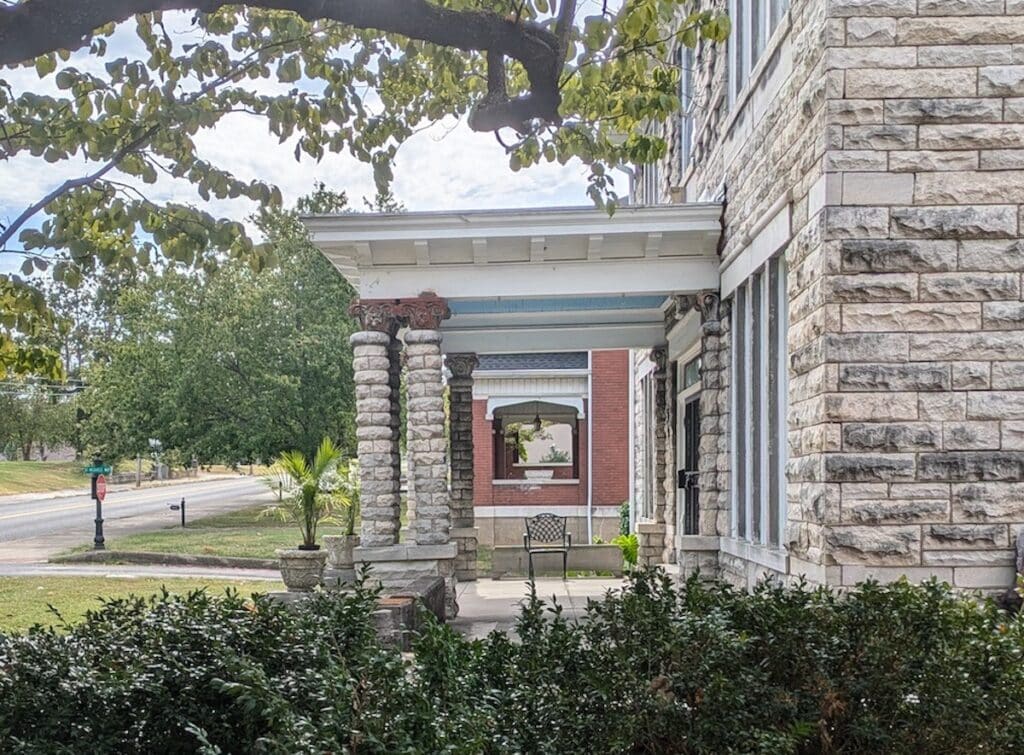
This was also true of the people who lived in these houses one hundred years ago. During that time, people used their porches as extensions of their homes’ interiors. Take a look at old family photographs from this era and see how many of them were taken on porches versus inside the house.
No early 20th century home in Hopkinsville was complete without a porch. Next time you walk down South Main Street, count how many of the houses don’t have one. Spoiler alert — there aren’t many! Porches represent the idea that neighbors talk to each other regularly and homeowners interact with passers-by.
I would hazard a guess that this was truer in 1900 than it is today. Technological changes have altered the way and the extent to which we use porches.
Porch practicality
When the Daltons built their house in 1907, a porch served a basic, essential purpose — air conditioning. In the dog days of summer, the Dalton house’s bricks bake in the sun, building up a battery of heat that lasts for days, even after the weather has cooled. This is a phenomenon we have become very familiar with this summer! This kind of weather pushed the Daltons and other early 20th century Hopkinsvillians out onto their porches.
Actually, the Daltons had not just one but two porches. If you’re familiar with the house, you probably know the front porch well. Visible from East Seventh Street, it spans the width of the house with a portico covering the middle bay. It’s stylish, with a concrete floor poured onto a limestone block foundation, all topped with a short, perforated brick wall with a limestone cap. The portico is supported by a pair of tripartite yellow brick columns.
It’s easy to imagine the occupants of East Seventh Street all sitting out on their porches, chatting while trying to cool off.
The back porch is not so stylish, but I have a hunch the Daltons used it more often than the front. In fact, the only historic photograph I have from the Dalton era shows Monroe, Margaret and Sarah seated on the back steps, circa 1915. (Many thanks to Patricia Pepper for this!) At the top of the stairs is a screened-in porch. The back porch was more private and bug-proof.
‘Healthier, happier, and more even-tempered’
Two technological innovations threatened the tradition of porch-sitting: air conditioning and television. And it seems that both appeared in Hopkinsville about the same time, in the wake of World War II.
Air conditioning appeared as a climate control potential in Hopkinsville as early as 1935. The Kentucky New Era ran an informational advertisement in August of that year, which asserted that “researchers say you’ll be healthier, happier and more even-tempered when you have it,” all claims that are undoubtedly true!
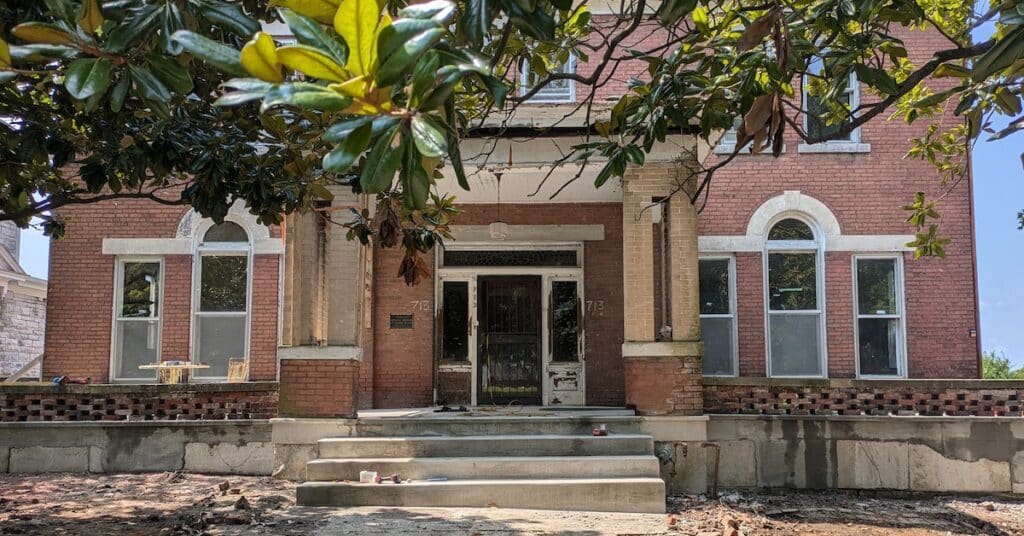
The first buildings in Hopkinsville to install air conditioning were businesses. In 1946, International Shoe Co. opened a factory on Harrison Street. They advertised the plant’s cooling system, which relied on a shallow pool of water that covered the building’s flat roof. This is called evaporative cooling, and it’s based on the same idea as sweating.
By 1948, George W. Davidson had opened a heating and cooling business on East Fourth Street, Davidson Fuel & Equipment Co. He pitched air conditioning to business owners for the comfort of their workers but also as a sales incentive. Apparently, shoppers prefer air conditioned stores to hot ones!
Air conditioning as a common feature in homes came on the heels of businesses. Residential architecture reflects this. Take a drive down Nelson Drive. This road was laid out about 1948, and the homes that line it sprung up over the next decade. Most of the houses have small stoops, but you won’t see many porches.
Age of entertainment
A second technological innovation that dramatically altered American life and leisure was the advent of television. Up until this point, entertainment was socially rooted. People attended shows, talks and dances, played music together, or sat on their porches and chatted with their neighbors.
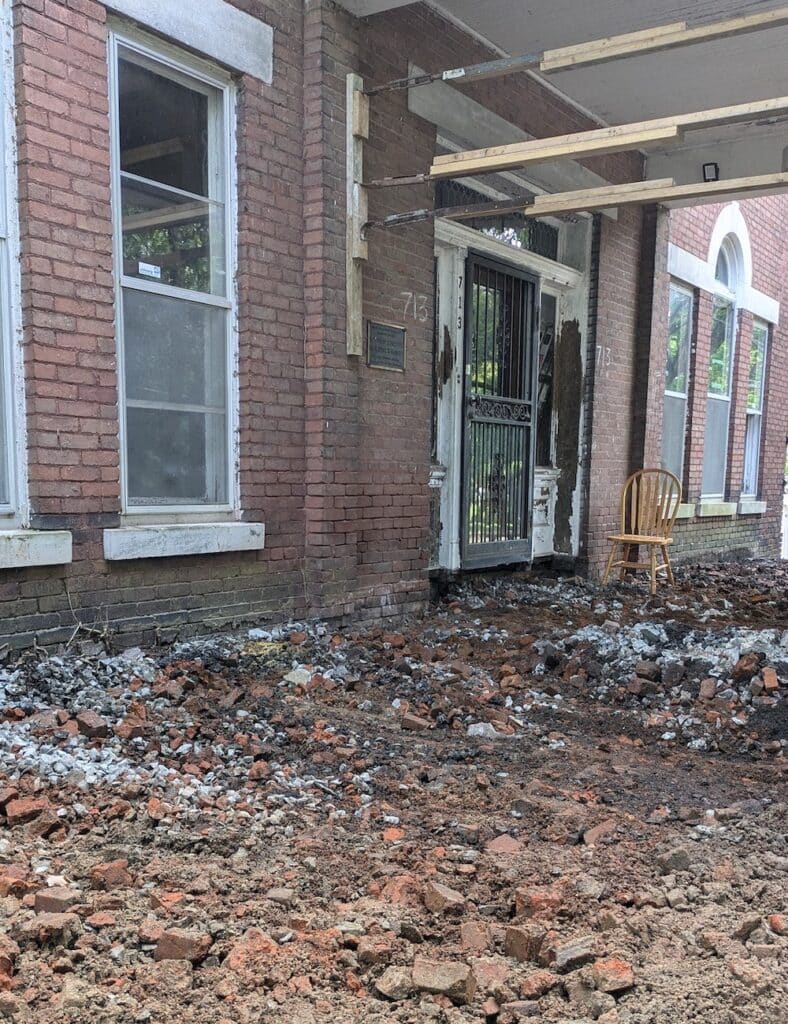
Debuting after WWII, television rapidly reached deep into the heart of American tradition and reordered it. Entertainment went from being based on interaction with others to becoming a product that was consumed. This wasn’t evident in the beginning, when televisions were rare enough that there was still a communal aspect to watching TV shows. But the stage was set for entertainment to become largely isolationist.
A column run in the Kentucky New Era in 1961 stated, “The public has accepted television as it hasn’t accepted any part of the entertainment industry in years.” (Bud Collyer, “The Voice of Broadway,” Kentucky New Era, Saturday, July 22, 1961)
Television in the comfort of air conditioning provided a double whammy to the tradition of porch sitting, drawing people inside their homes, in front of the TV for their hours of leisure.
Front porch work
We currently have minimal air conditioning, and I try to pretend that we don’t have a television. The result is that we’ve spent quite a lot of time on our front porch this summer, relaxing as well as working.
The porch’s concrete top was cracked, and the steps down to the driveway were so crumbled as to be unusable. The main culprit was an enormous varnish tree (also known as heaven tree and, more appropriately, hell tree), which had grown up from the foundation. Extremely tall and straight, this tree had shot up 70 feet in just 20 years and poked its way through the foliage of the neighboring trees. The varnish tree’s rapid growth mangled the west side of the porch, cracking and crumbling it.
- SUBSCRIBE: Sign up for our newsletters

The rest of the porch and the front steps were also deteriorated and criss-crossed with cracks. We knew the whole concrete slab would have to be torn up and repoured. We’ve done a lot of the work on the house ourselves, but this was a job we knew we’d need to hire someone to do.
We took down the varnish tree ourselves in July, which was tricky because it had grown leaning over the portico roof. After that, Jim Winstead pulled up and repoured the porch and stairs. I’ve always been curious as to what lay beneath the concrete pad. We dreamed of finding a time capsule. What we found instead was dirt and broken brick!
Our porch work continues this fall with reattaching the foundation’s limestone faces, which had fallen off over time, and rehabilitating the portico. There’s still a lot to do.
But, for now, it’s nice to be able to sit on the front porch and cool off, enjoying the breeze and the view up East Seventh Street in the same way as countless others who’ve lived in this house.
Grace Abernethy is a historic preservationist and artist who specializes in caring for and recreating historic architectural finishes. She earned her Master of Science in Historic Preservation from Clemson University in 2011 and has worked on historic buildings throughout the eastern United States. Abernethy was a recipient of the South Carolina Palmetto Trust for Historic Preservation Award in 2014 and won 2nd place in the Charles E. Peterson Prize for the Historic American Buildings Survey in 2011. She and her husband, Brendan, moved to Hopkinsville from Nashville in 2020. She works as an independent contractor and is a board member of the Hopkinsville History Foundation.


